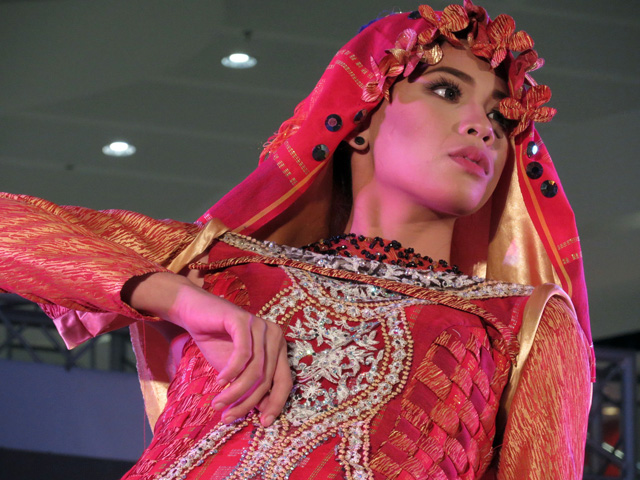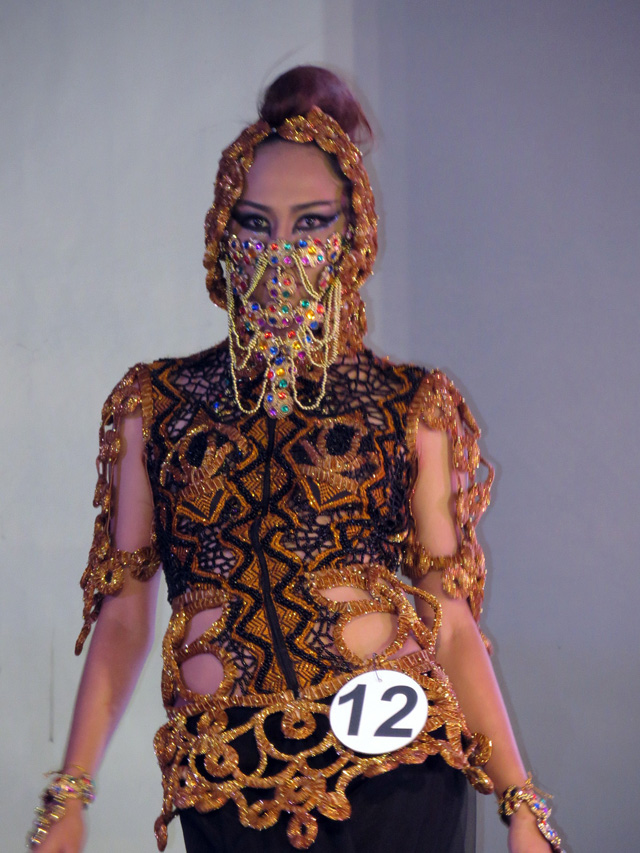The people of Cotabato City take pride in the Inaul because it represents their vibrant cultural heritage. The understated elegance of the fabric and its colors express the “Maguindanaoan state of being” in a way that no other piece of garment can.
Traditionally, yellow and orange represents royalty; red symbolizes bravery and courage; and green signifies peace and tranquillity. White is the color of purity, sadness and mourning; while black represents dignity.
 The colors and detail of the Inaul proved to be a designer’s gold when it took modern silhouettes and form in this year’s Moda Mindanaw fashion design competition on August 23. The event was staged in partnership with the Province of Maguindanao.
The colors and detail of the Inaul proved to be a designer’s gold when it took modern silhouettes and form in this year’s Moda Mindanaw fashion design competition on August 23. The event was staged in partnership with the Province of Maguindanao.
The intrinsic value of the hand-woven fabric upped a notch when it came to life in the runway of SM City Davao’ Annex as it robed models from top to toe.
The participating designers who hailed from South Cotabato, Davao del Norte, Davao del Sur, and Cotabato City paraded 36 ensembles that made use of the Inaul in long gowns, cocktail dresses, and men’s formal wear.
South Cotabao-based designer Joey Hambala, for instance, used the Inaul to add texture to the corset of the cocktail dress that he made. His piece featured tassels, fringes, and braids of the Maguindanaoan fabric. He won cocktail dress category of the competition. Joey didn’t have any formal training in fashion but he has been under the tutelage of designer Ivan Raborar who has also won previous Moda competitions. Joey dreams of dressing up a beauty queen someday and continues to hone his craft by researching and watching fashion videos online.
Niko Martinez’s winning entry for the men’s formal wear category was a silk-Inaul suit with sequins and golden laces all over, accentuating the structured look with details strongly associated with Mindanao royalty. Niko has had his fashion skills trained through designing wedding dresses when he worked in a bridal shop some years ago. He took the Moda Mindanaw challenge and discovered that he can be equally skilful in making men’s wear.
Jared Servano had an avant-garde take on the long gown. He took inspiration from the wood carvings of the Maranao and the Sarimanok and had Baroque-like “skeletal” details looping in the bodice. His dress’ pièce de résistance was the incredibly detailed mask that transformed into a huge collar when unzipped. In an interview, Servano humbled himself as someone who only interprets the native Mindanao designs. He said that the real designers are those who are at the front of creating materials for dresses (he shares the T’boli who weave as an example).
 There are other Inaul interpretations worthy of notice, too: the long turquoise gown by Aries Buenvenida, and the cocktail dresses peppered with appliqués, beads, and sequins by Celso Laug Laug and Marlon Suan.
There are other Inaul interpretations worthy of notice, too: the long turquoise gown by Aries Buenvenida, and the cocktail dresses peppered with appliqués, beads, and sequins by Celso Laug Laug and Marlon Suan.
During the show, Manny Deiparine’s designs also basked under runway limelight. Deiparine has been a consistent winner in the previous editions of the fashion competition. He hails from Maguindanao and prides in using the Inaul in his designs. He has clothed many of the royalties of Maguindanao.
In an interview, M magazine fashion editor Otoi Mercado said that locally sourced materials like the Inaul and its Mindanao contemporaries (T’boli T’nalak, Bagobo beadworks, Maranao brass, etc) are just some of the things that make the Mindanao fashion scene tick. “Every small object gives a contribution to how the industry here in Mindanao moves. And every person—whether an amateur or a professional designer—who contributes to supporting fashion in Mindanao is vital especially when it comes to saving and preserving the authentic tribal/ethnic produce here.”
“The Mindanao designer is like a sponge who easily absorbs ideas coming from celebrated and current fashion names,” Mercado said; he was one of the judges in the event. “They give it their own interpretation using the available material they can source—and we are lucky in that area because we have an abundance of that. We can use these for modern patterns, designs, or texture.”
The first Moda Mindanaw fashion competition was held in 2006 and since then has been a gateway for local designers to showcase Mindanao art and culture through fashion. The event is often staged alongside Davao’s Kadayawan Festival events. Since then, the competition has been a celebration of local artistry when it comes to bringing into everyday wear Mindanao’s prized fabrics and materials. (Jesse Pizarro Boga/MindaNews)
